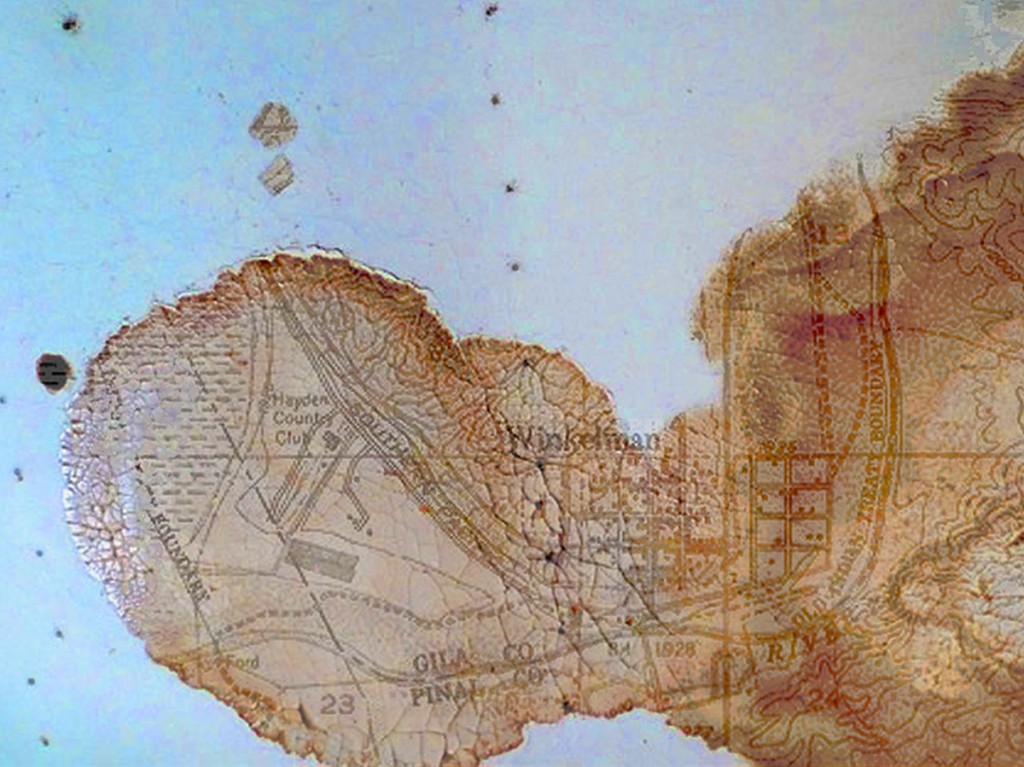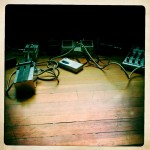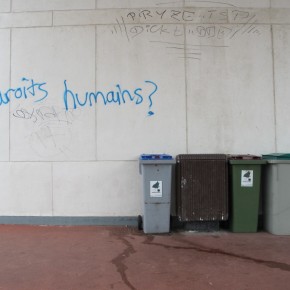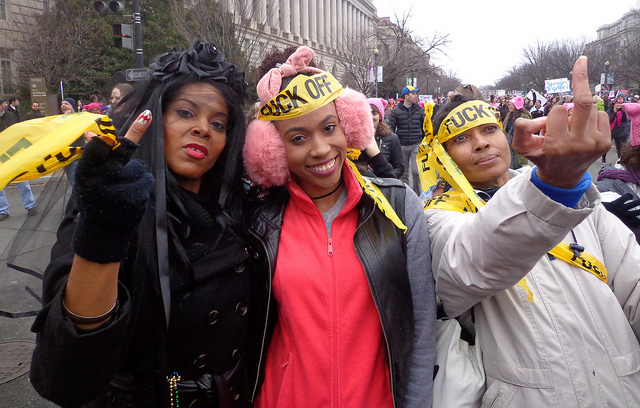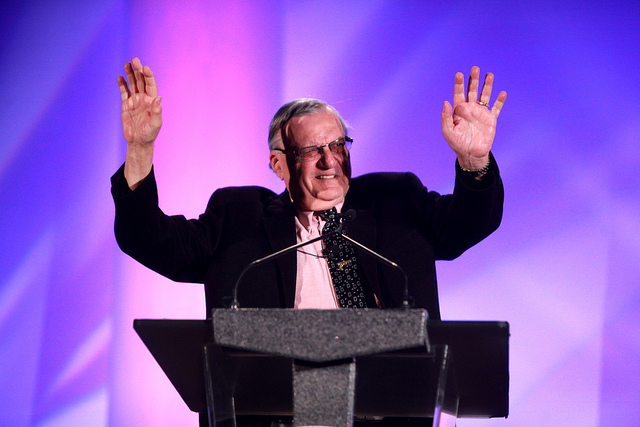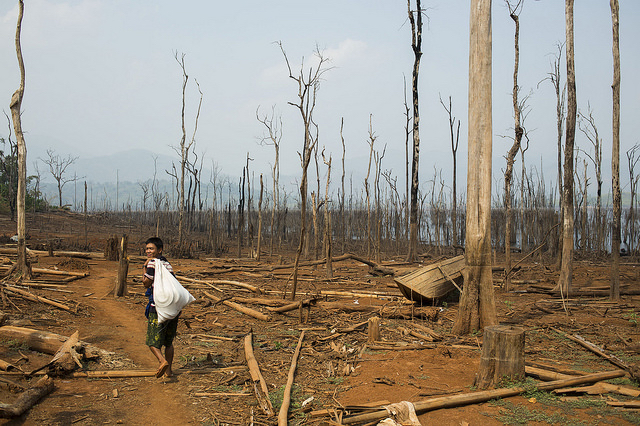This piece, part of the Copper Belt Project, is the third in a series — listed here — exploring the forgotten people and places of an iconic American landscape scarred by a history of economic and environmental violence.
FEBRUARY 26, 2011
14:30
As the plans for our Copper Belt Project fell into place, my collaborator Mark Hahn and I started traveling through the region in a new way. Instead of letting chance be our guide, we began to revisit our favorite locations. One of them was an old, abandoned motel in Winkelman, Arizona.
It’s an incredible place. And we hadn’t even scratched the surface of its photographic potential. But as we drove down the hill through town on a bracing February day, I spotted a sign for an abandoned café. “Let’s stop there!” I blurted out. Mark immediately agreed, so we parked the car and began exploring.

The view from the street
When I walked into the gutted building, I was delighted to find that it was every bit as beautiful as I’d hoped it would be. But I could also tell that we weren’t alone. Someone out back was moving things around. He seemed to be hauling wood and stacking debris. Normally I would have left the building, as if I were trespassing. When I caught some glimpses of the man through the back door, though, he seemed singularly focused at the task at hand. For some reason, I felt no threat and didn’t feel like I needed to leave, so I explored the building some more while he continued working out back.

The emptiness within
Through the corner of my eye, I would periodically catch the image of his body moving and stacking things out back, but somehow it felt okay to be there, so I continued photographing while the man out back continued working.

Tools amid the rubble
At first, I noticed relics of the old café, a spatula, a pot lid. There was a beautiful ordered symmetry to the garbage. Then I noticed something that seemed a little odd. Old mattresses were stuffed into door frames on the side of the wall, and holes in the walls were stuffed with old rags.

It gets cold in here
I was taking photos of the mattresses when I heard Mark talking to the man outside, so I went out back to see what was happening. That’s when I met Pablo. I learned that he was cleaning out the abandoned café and making it his home in the process. The mattresses, it turned out, were stuffed into the doors to keep his living quarters warm.
He talked about the hard work he has done to clean out all the garbage and make the place livable. He had single-handedly removed piles and piles of old junk and stacked it tidily outside the café. As he told us about cleaning up the place, I learned that he had worked at the Ray Mine for seventeen years before losing his job.
Pablo invited us inside to see all the work he had done to fix up his home. He showed us the stove he had built to keep the place warm. Since we had met him in the middle of an unusual cold spell with below-freezing temps every night, I was glad had a stove. I asked him about the ventilation, making sure he wasn’t going to asphyxiate at night. He explained that he had constructed the stove to ventilate properly.

Venting the bad, trapping the good
Then he gave us a tour of the place. He showed us where he sleeps at night and told us how the stain on the ceiling looks like Jesus. He explained that he used to be nervous at night, but felt safe once Jesus appeared to him in the stain.
Because the stain was obviously very important to him, I made sure to get a clear photograph. Then it occurred to me that I should document it for Pablo as well as my future readers. Because if he ended up having to go somewhere else someday, he would want a record of the miracle that sustained him through difficult times.

Rising above
He opened up plastic grocery bags and offered us bottled water, crackers, cookies and other snacks. He showed us stacks of books and magazines he likes to read. Then he took us back outside to show us more of the work he’s done.
He led us into one room that he had emptied completely. He said that he cleaned it out and made it his job to watch over it and keep the kids on meth from hanging out there and burning the place down. Not surprisingly methamphetamine abuse is an epidemic in depressed mining towns like Winkleman. (See Nick Reding’s book Methland.)

The memory of pain hangs in the air
Standing inside this room, Pablo explained how a kid had hung himself there, that he had helped take down the body. Apparently this teenage boy had been the son of the café’s former owners. But Pablo assured us that, since he had started watching over the place, the meth kids were leaving it alone.
He then took us out back to show us where the bathroom used to be. As he led us up the little concrete stairs to the bathroom, Pablo paused, a lump caught in his throat, tears welling up in his eyes, and he said, “I like this place.”

Home is where the heart is
MARCH 18, 2011
17:22
We headed up to Winkelman again just three weeks after meeting Pablo. As I had promised him, I had made photographs from our visit to give to him the next time we drove through town. I had them in an envelope and was really looking forward to seeing him and showing him the photos.
We pulled up to his place, but there was no sign of Pablo. The door to the part of the café where Pablo lives was boarded shut with a padlock on it. The room next door had boards placed across it. Large letters had been scrawled across the boards in pink chalk: DO NOT ENTER. UNSAFE.

Marking the boundary
I knew these words were written by Pablo, that it was his way of carving out space for himself in a spaceless world. There was something so innocent, heartbreaking and human about the use of pink to write these words. I stood outside holding the photos in my hand. I called Pablo’s name. “Pablo!” I was only answered by afternoon light spilling through the hollow windows.
Trucks rumbled on the street above where workers were driving home from their day at the Ray Mine. I looked around and noticed that Pablo had really cleaned out the place since our last visit. The floor was swept clean, and a pile of scrap metal was piled on one side of the room. I stepped over the boards and walked into the room looking for any signs of Pablo. I called his name again. Still no answer.
Out back, grass and tree leaves rustled in the breeze. Other than that, the place was hushed. I leaned my ear to the mattress that separated this room from the room where Pablo sleeps. Silence. I called Pablo’s name again. Nothing. I looked down and studied the pile of scrap metal and cans collected on the floor.

Caring is in the details
I found such beautiful symmetry there, as if each piece had been carefully placed to present a whole singular object, a kind of art installation made from junk. There was such precision to the way that Pablo had collected and ordered these pieces of debris. There was something quietly beautiful, a kind of aesthetic formality in the way Pablo sorted materials as he cleaned out the café.
I walked into the back room and found one old pair of scissors and a spoon resting on a windowsill. They obviously had been sitting there for years, yet their arrangement seemed so deliberate.

Artfully placed
Pablo had made the choice to leave these things here. In one empty corner a makeshift stool made out of a cinder block and a cement stepping stone stood like a minimalist sculpture, a simple totem created out to mark this place as home, to stake a claim, to say “This is my place. I love it. I can make it beautiful.”

Balancing act
I snapped a photo and hoped that Pablo would be returning to his home, that he hadn’t vanished, that we would find him next time. I stood for a minute and listened to the silence. We climbed back into the car. I put the photos in my bag, and we drove off.
APRIL 2, 2011
14:30
We weren’t expecting to go Winkelman that day. We just kind of ended up there on our way to somewhere else. Walking down the hill, I saw Pablo step out of his place. I was so happy to see him. “Pablo!” I shouted. “Hey,” he said with a big smile, so happy to see me and Mark, “Where are my photos?”
I felt so bad. I hadn’t brought the photos with me because I hadn’t been expecting to stop in Winkelman. I told Pablo how we had come by to visit him a couple of weeks ago but couldn’t find him, that I did make photos and would bring them to him next time we were in town. He smiled with that kind of smile that says, “Sure. Right.” I could tell that he was used to people saying they were going to do things that hey never ended up doing. I assured him I’d be back soon with the photos. We shook hands and parted ways.
APRIL 22, 2011
17:30
For weeks I carried those photos around with me, waiting for the next time I could make it to Winkelman and see Pablo. Nothing else seemed important to me about Winkelman other than finding Pablo, making sure he was okay, and giving him the photographs I promised him. Finally, we made it back to the town.
We pulled up to the old café, and I noticed that the padlock wasn’t on the door. I felt a burst of hope. I climbed out of the car, stood outside, and called Pablo’s name. “Pablo!” I shouted. Inside, I heard some mumbling and rustling, then Pablo’s voice asking, “Who is it?” I answered back, “Kim and Mark, your photographer friends.”
Pablo immediately recognized who we were and came out to the door to greet us. He met us with a huge smile. He was so happy to see us, so happy that we took the time to stop by and see him. Before he could ask, I handed him the envelope with the photographs. “Look, I brought you the photos I promised you,” I said.

Something to hold onto
Pablo’s face lit up like it was Christmas. He took the photos out of the envelope and started looking at them. “These are just great,” he kept saying. Then he got to the photo of the Jesus stain on the ceiling. I printed that one out special because I knew it was so meaningful for him. He held it up, and his whole face settled into a peaceful calm. He shook his head with awe. “This is really beautiful,” he said.
“Do you want to come in and see the place?” he asked. “I’ve really fixed it up since you saw it last time.”
He lead us through the building. The mattress that serves as the door to his room stood ajar. Another mattress leaned to the wall on the right. A large puddle of water spread across the floor. An empty water jug stood to the side. It must have spilled. There’d been no rain. This leak must have come from somewhere inside.

Something must have cracked
When we walked into Pablo’s room, the first thing I noticed was a big comfy bed. “You have a bed!” I said excitedly.
“Yes, I do,” Pablo said. He sat down and gave a little bounce. Then he sat quietly looking through the photos again. I decided I needed to know more about him. “You worked at the Ray Mine, right?” I asked.
“Yes, I worked at the mine,” he said. “For many years. Then something happened.”
Pablo’s voice cracked, and he dropped his head in thought. “You won’t believe me if I tell you,” he said.
“You can tell me anything,” I told him, “I’ve been through so much in my life. Nothing you tell me is going to scare me or shock me.”
That got Pablo to begin his story. It was a hard one. He told me about his sister and mother, how they had kicked him out of the house, something about lies and restraining orders. “It was bad,” he kept saying. “Very bad.” Then he pushed his face close to mine, and he told me about the cameras, the ones on his face, the ones that are watching his every move. He opened his wallet and pulled out a tiny diamond earring.
“See this diamond,” he said. “I found it in my nose. I knew this was how they were watching me, so I pulled it out.” Pablo held out the little sparkling diamond in the palm of his hand. Then he lifted his face toward mine, his eyes brimming with tears. He pointed to his nose and said, “Look, you can see the hole where I pulled it out.”
I looked. There was a tiny hole at the base of his nose. As Pablo told me his story, I listened and said things like, “It must be hard,” and “Your place really looks nice.”
Pablo told us that the place was going to be bought by a couple of guys in Superior who want to turn it into a restaurant. Mark and I had actually met those guys on our first trip through Superior. We knew exactly who they were.
“What will happen to you when it becomes a restaurant?” I asked.
“I’ll stay and take care of the place,” Pablo said.

Some things to watch over me
Indeed, it did seem that someone is looking over Pablo. He says his mother brings him food and supplies. He lives in this place, yet the townspeople obviously leave him alone and let him do his thing. He sweeps; he cleans; he stacks and sorts debris. He lights a candle for Jesus. He says he prayers.
When he told me the story of the cameras and the diamond, I wasn’t sure how I could write about Pablo in a way that would do him justice. He has created order out of chaos, finding peace in an environment that is tainted with economic and environmental pollution. That’s an impressive achievement, even if it’s not the existence that he would have chosen for himself.
In the end, I decided that I could only write about him the way I would write about any other person. Pablo lives his live. He has had his ups and downs. And he has a story to tell, which is more than many people can say. I’m glad that I know him and that he knows me. I think of him as my friend. I’m glad I could make him smile by bringing him my photographs.

Weapons against chaos
As we were leaving, I looked over and to the side of the room and noticed a rake, a broom, a shovel, and some kind of scythe leaning against the wall. They were displayed in perfect order next to a pile of dead branches, the pile yet another creative sculpture that this man has created out of the wreckage people left behind. The aluminum scraps, the dead branches, the cinder block, the scissors — everything in Pablo’s place seems to be the product of conscious deliberation. He takes meticulous care of every inch of his environment. Yes, it is an environment in flux, but he creates stability by organizing the chaos and then occupying it.
We stepped outside, and Pablo opened his arms to me. I opened mine in return and gave him a big hug. He held up the photo of the ceiling stain Jesus and said, “Thank you so much for this. It’s Good Friday today, you know?” I said, “I’m so glad we found you at home Pablo. We’ll stop by next time we’re in town.”
That’s when he corrected me. “It’s Pancho,” he said. “P-A-N-C-H-O.”

That’s what I call myself
I felt kind of awful that I’d been calling him by the wrong name all this time, but then again, I was positive that he had answered to Pablo the first time we had met him. But I just said, “I’m terrible with names. I’m so sorry. I promise I’ll get it right next time!”
“That’s okay,” he smiled and extended his hand. I shook his hand and said, “Bye Pancho. See you next time!”
He looked down at the photograph of the ceiling stain Jesus then back up at me and said, “Happy Easter!”
“Happy Easter,” I said in return and thought how it was kind of perfect that I had been able able to give Pancho the photos on Good Friday.
As we drove off, I wondered if I would ever be able to write Pancho’s story. But I realized that his is the same kind of story I’m learning every time I return to the landscape of the Copper Belt. Not only does my perspective on places change, but my perspective on people changes too. In the case of Pancho, the more I learn about him, the more I feel connected to him. He has been generous in sharing his home with me. He has been generous in sharing his smiles and hugs with me. He has been generous in sharing his life with me.
I hope that diamond is tucked away safe in his wallet. And I hope I’ll find him next time I visit Winkelman. If he is there, I will give him a copy of this story. HIs story.
